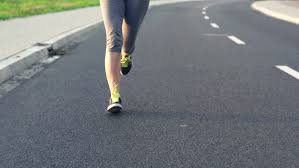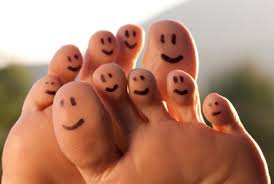Want to get started on an exercise program but haven’t done any exercising for a while, or ever?
Try walking!
You’ve probably heard about the benefits of a walking program, like—
- Social benefits
- Brain health
- Heart health
- Toning and weight loss
- and, best of all, Mental health—Getting Outside in Nature and Fresh Air!
We’ll cover the benefits in more detail in future posts. But today we’ll look at how to get a walking program started.
First things first—
If you’re just starting a walking program, what do you think you first need to consider?
If you said your conditioning level, you’d be partially correct. But we’ll cover that point next week.
The first things you need to consider are:
- Where you’ll be walking; and
- What equipment you’ll need.
Equipment? Yup. Those shoes you’ll put on your walking feet.
One of my specialties in sports medicine was the biomechanics of the lower extremities. A fancy title for how the hips, thighs, knees, legs, ankles and feet work together when moving, or ambulating, to be exact, on a surface. I would observe you walking across a floor or on a treadmill and discern where you had a biomechanical problem in any of those areas that might cause injuries in a particular joint or body part.
One of the courses sparking my interest in this area was the conference “When Your Foot Hits the Ground, Everything Changes!” And it’s so true! Your gait can cause a chain reaction that spreads clear up to the spine, trunk and shoulders. And neck and head.
I can’t stop evaluating people’s movements. It’s automatic for me to mentally assess everyone I see out on the road running or walking. I cringe when I see people running (or some version you’d try to describe as running) and know they’d be better off physically and efficiency-wise walking rather than doing what they’re doing. It makes me shudder to see them move. And my brain automatically compiles a list of all of the physical problems they must have, or will likely have from their efforts.



First—What’s your training surface?
This is one of the first things a knowledgeable sales person will ask you. What do you plan to use your shoes for? Running, walking, cross-training, etc.
And you need to know what kind of surface you plan to train on.
Will it be asphalt, packed dirt, a combination, inside track, treadmill? Your surface will decide the shoe tread and style.
For example, I’m training to walk the Camino de Santiago, the pilgrimage path in France and Spain. It covers a range of surfaces, including asphalt, hard packed dirt and other assorted surfaces, if I wander off the main path. My first choice would be trail running/walking shoes. Why? Because they have great, nubby soles that grip uneven surfaces. They’re good for day hikes on mountain paths and trail running.
But those great little grabby nubbies will quickly break down on asphalt. For asphalt, I’d need a road shoe. So I may carry both with me.
Sound indulgent? For me, it’s critical. My feet are so beaten up and broken down from gymnastics and dance that I need shoes that will go the distance (and surface) for me. And because of my flat feet, plantar fasciitis and pronation-supination problems, I have to be really picky. My shoe choice is an Altra.
I fell in love with my Altra trail shoes, with their wide toe boxes that let my toes splay out, wiggle and breathe. I violated my own rules with them, though, and wore them everywhere, so they broke down quickly, and I have to buy another pair. This time, though, I’ll be buying both the trail and road models. And I’m also training in Keen hiking boots that have a lower ankle profile, since I don’t like the high ankle style. It’s too constricting for me. My older son swears by the higher ankle, though. The takeaway?
Get the type of shoes you need and feel comfortable in!
FYI: I DO NOT get any money from Altra shoes for recommending them. There are a lot of good shoes out there. Do your research, go to a good store, a store focused on runners and walkers and outdoor enthusiasts is best, although I wouldn’t recommend Big 5. While I have purchased shoes there (they often sell last year’s models at reduced prices), I know what I’m looking for. But I have my doubts about whether their sales staff is knowledgeable enough about shoes to make a good recommendation, or fit you properly.
I’m a REI shopper. Their staff is knowledgeable and helpful! Summit Hut would be another great place to go too. But in either case, I do not recommend purchasing shoes online, unless you’ve already tried them on in a store, or you’re re-ordering a shoe you know works for you!
Then—what shoes to buy!
When a patient came in to see me, one of the first things I did was evaluate their shoes.
- Were they wearing running shoes or shoes made for walking or tennis, or just casual strolling?
- What did the wear patterns on the bottom of their shoes tell me about their gate or issues they might have?
- Did they need orthotics or “posting” in their shoes to help alleviate stressors?
And the big question?
Had they outworn their shoes? Had their shoes broken down to a point where they needed to be trashed and new shoes purchased. Take Note! A typical exercise shoe, if worn daily, will last you only 3 -5 months (although some manufacturers claim a longer period). Ask the sales person how many miles you could expect to put on the shoe before having to replace it. That will give you a better idea of how long they’ll last. But don’t balk at buying an expensive shoe. This piece of equipment is critical to your physical health! A fact most people never think about.
What shoe is right for you?
Shoes are usually built on what is called a last—a mechanical form having the same shape or form as a human foot. Back when I was in practice, most shoes were built on a man’s last, meaning everyone—male and female—had shoes built primarily for a man, with only minor modifications made. Yuck!
Today, women’s shoes are built on a women’s last (thank goodness!). And you have a wide variety from which to choose! (That can be a challenge just by itself!)
So the first thing you need to do is buy the right shoes! And to buy the right shoes, you need to make a few notes about what kind you need.
First, decide whether you’re a beginner, intermediate, advanced or extreme exerciser. Your answer will help in selecting the shoe that’s best for your ability level.
And PLEASE don’t plan to wear the shoes you’ve had in your closet for years, or the ones you use to clean up the backyard. Your feet change over the years, and you need shoes that accommodate that change. Do you have flat feet that need more support? Do you have high arches that need a ton of support? Do your feet roll inward when you walk? Does your forefoot roll outward when you push off?
Spend some time watching yourself walk, by walking toward a big mirror at a gym or at home. Watch your feet, how they move. Have someone stand behind you and watch you walk forward. What do they see? Write it down. Then take that information with you to a GOOD shoe store, one where the sales staff understands shoes and styles and customer needs, and don’t just try to sell you the “latest and greatest” and priciest model.
Try them on with the socks you plan to wear. Run around the floor with them on. Jump up and down. Don’t pick out the cheapest just because they’re cheap. Plan to spend some money and pick out comfortable shoes that do what you need them to do.
Your feet—and the rest of your body—will be so happy you did!

And take care of those shoes!
You’ll make a big investment in your footwear, so take care of your shoes so they can take care of you.
- Lace them correctly!
- Unlace them when removing them, instead of stepping on them with the opposite foot to yank them off. You’ll break down the back of the shoe.
- Remove the liners/arch supports, if they come with them, to air out.
- Keep them clean and remove the rocks and pebbles that might lodge in the treads.
- Know how your shoes should be cleaned and clean them properly.
- Don’t squash them in your bag or suitcase. Make sure they have room so they won’t get broken down when packed.
For those of you who would like to get a jumpstart on researching shoes, here’s a link to a great article in “The Strategist.” It lists some of what they think are the best running, training and workout shoes available for women and why. (They even have tips for beginners.) You can find good shoe recommendations for men on their site too.
Have fun shoe shopping!
http://nymag.com/strategist/article/best-running-shoes-workout-shoes-women.html
NEXT WEEK—we’ll talk about the progression of a good (effective) walking program and how to get the most benefit from it. I’ll give you some tips to avoid injuries and even cover why a walking program may not be good for you.
Until then,
Blessings,
Andrea
May you prosper in all things and be in health, just as your soul prospers (3 John 2).
